The best tourist places in India
For those interested in exploring its wonders, India, a nation rich in history and culture, offers a wide range of experiences. India’s varied landscapes, ranging from sun-kissed beaches along its extensive coastline to the snow-capped peaks of the Himalayas, provide a centuries-spanning setting for an incredible tale. The cultural tapestry is equally rich, with motifs drawn from historic customs, holidays, and architectural wonders. On this journey, we will explore the historical treasures that epitomize India’s enthralling charm, traverse the magnificent highlands of the north, and unwind on the tranquil beaches of the south.
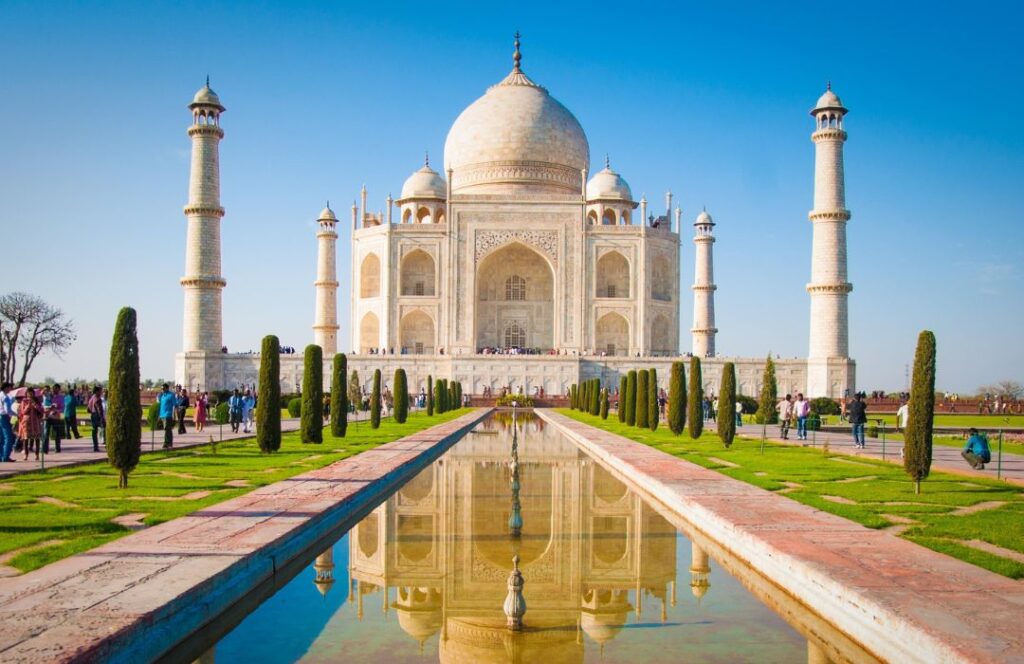
Agra's Famous Taj Mahal, India
The Taj Mahal, gracefully perched on the edge of the Yamuna River, stands as a timeless testament to architectural genius and love. Delve into its past, and the story unfolds to reveal the grand vision of Emperor Shah Jahan, who commissioned this marvel as a tribute to his beloved late wife, Mumtaz Mahal. Adorned with exquisite gardens and intricate marble carvings, the ivory-white mausoleum serves as a poetic embodiment of eternal love.
Stepping into the hallowed grounds of the Taj Mahal offers not just a journey through Mughal history, but also a poignant exploration of the love story that inspired the creation of this iconic structure, leaving an indelible mark on the cultural landscape of North India.
Located approximately 6 km from the nearest railway station, Agra Cantt, reaching the Taj Mahal is convenient via taxis, auto-rickshaws, or cycle rickshaws. The monument is open to visitors from sunrise to sunset, offering enchanting views throughout the day. The best time to visit is during the cooler months of October to March, avoiding the scorching heat of summer. Ticket prices vary for domestic and international visitors, with additional fees for entry into the main mausoleum and other areas
- Location: Situated on the banks of the Yamuna River in Agra, Uttar Pradesh, India.
- Distance from the nearest railway station: Approximately 6 km from Agra Cantt Railway Station.
- Transportation options: Taxis, auto-rickshaws, and cycle rickshaws are available for easy access.
- Opening hours: Open to visitors from sunrise to sunset, seven days a week.
- Best time to visit: Cooler months from October to March are ideal, avoiding the extreme heat of summer.
- Ticket prices: Vary for domestic and international visitors, with additional fees for entry into the main mausoleum and other designated areas.
- Booking tickets: Tickets can be purchased online or at the ticket counters near the entrance gate.
- Photography: Photography is allowed but certain restrictions may apply, especially inside the main mausoleum.
- Security measures: Visitors are required to pass through security checkpoints before entering the monument premises.
- Guided tours: Guided tours are available for a more informative experience, offering insights into the history and architecture of the Taj Mahal.
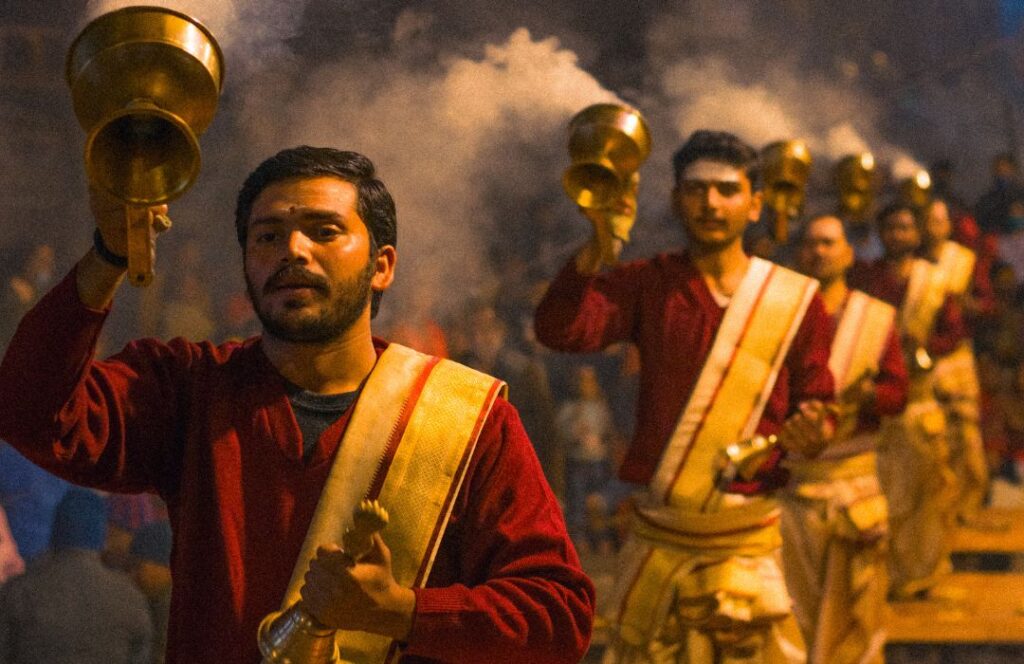
Varanasi, the Cultural Capital, India
Nestled alongside the sacred Ganges, Varanasi stands as the vibrant heart of spiritual enlightenment in India. Revered as the “city of temples,” its ancient shrines, bustling ghats, and labyrinthine lanes echo with centuries of devout practice. Varanasi holds a profound significance in Hinduism, believed to be a gateway to salvation beyond the earthly realm. Each evening, the mesmerizing Ganga Aarti ceremony unfolds on the riverbank, as priests illuminate the darkness with flickering lamps, captivating pilgrims and tourists alike with its mystical ambiance and blessings from the divine.
Beyond the enchantment of the Ganga Aarti, Varanasi pulsates with a tapestry of rituals, each weaving into the city’s rich cultural and spiritual fabric, beckoning visitors from around the globe to immerse themselves in its transcendent aura.
Situated approximately 3 kilometers from Varanasi Junction Railway Station, reaching this spiritual haven is convenient via taxis, auto-rickshaws, or cycle rickshaws. The city welcomes visitors from dawn to dusk, allowing ample time to explore its sacred sites and vibrant streets. The best time to experience Varanasi’s mystical allure is during the cooler months, from October to March, avoiding the intense heat of summer. Ticket prices for specific attractions within Varanasi may vary, with some sites offering free entry while others may require a nominal fee.
- Location: Varanasi is situated beside the Ganges River in the state of Uttar Pradesh, India.
- Distance from the nearest railway station: Approximately 3 kilometers from Varanasi Junction Railway Station.
- Transportation options: Taxis, auto-rickshaws, and cycle rickshaws are readily available for travel within the city.
- Opening hours: Varanasi is accessible to visitors from dawn until dusk, allowing ample time to explore its sacred sites and vibrant streets.
- Best time to visit: The optimal time to experience Varanasi’s mystical allure is during the cooler months, from October to March, to avoid the intense summer heat.
- Ticket prices: Admission fees may vary for specific attractions within Varanasi, with some sites offering free entry and others requiring a nominal fee.
- Main attraction: The mesmerizing Ganga Aarti ceremony, performed by priests with burning lamps on the riverbank every evening, is a must-see for pilgrims and tourists alike.

The Magnificent Himalayas (Manali, Shimla), India
Shimla and Manali stand as unrivaled jewels of natural beauty, nestled amidst the majestic Himalayan range. Shimla, with its tree-lined boulevards and panoramic vistas, exudes colonial elegance, while Manali captivates with its serene landscapes and alpine charm. The awe-inspiring scenery of these hill towns serves as a testament to the grandeur of the Himalayas. Beyond their picturesque surroundings, adventure seekers find sanctuary amidst these mountains.
Located approximately 342 kilometers from Chandigarh Railway Station, Shimla and Manali are accessible via road, with buses and taxis offering convenient transportation options. Both destinations welcome visitors throughout the year, each season presenting its own unique charm. The summer months, from April to June, offer pleasant weather ideal for sightseeing and outdoor activities, while the winter months, from December to February, transform Shimla and Manali into a haven for skiing enthusiasts, drawing travelers from across the globe.
Opening and closing times for specific attractions in Shimla and Manali may vary, with most tourist spots operating during daylight hours. Ticket prices for attractions such as museums, parks, and adventure activities may also vary, with discounts often available for students, senior citizens, and group bookings.
Shimla:
- Location: Shimla is located in the state of Himachal Pradesh, India.
- Distance from the nearest railway station: Approximately 342 kilometers from Chandigarh Railway Station.
- Transportation options: Accessible via road, with buses and taxis offering convenient transportation options.
- Best time to visit: April to June offers pleasant weather ideal for sightseeing, while December to February is perfect for skiing enthusiasts.
- Opening and closing times: Specific attractions may vary, but most operate during daylight hours.
- Ticket prices: Admission fees for attractions such as museums, parks, and adventure activities may vary.
Manali:
- Location: Manali is also situated in the state of Himachal Pradesh, India.
- Distance from the nearest railway station: Similar distance as Shimla, approximately 342 kilometers from Chandigarh Railway Station.
- Transportation options: Accessible via road, with buses and taxis offering convenient transportation options.
- Best time to visit: Similar to Shimla, April to June offers pleasant weather, while December to February is ideal for skiing.
- Opening and closing times: Similar to Shimla, specific attractions may vary but generally operate during daylight hours.
- Ticket prices: Similar to Shimla, admission fees for attractions may vary.
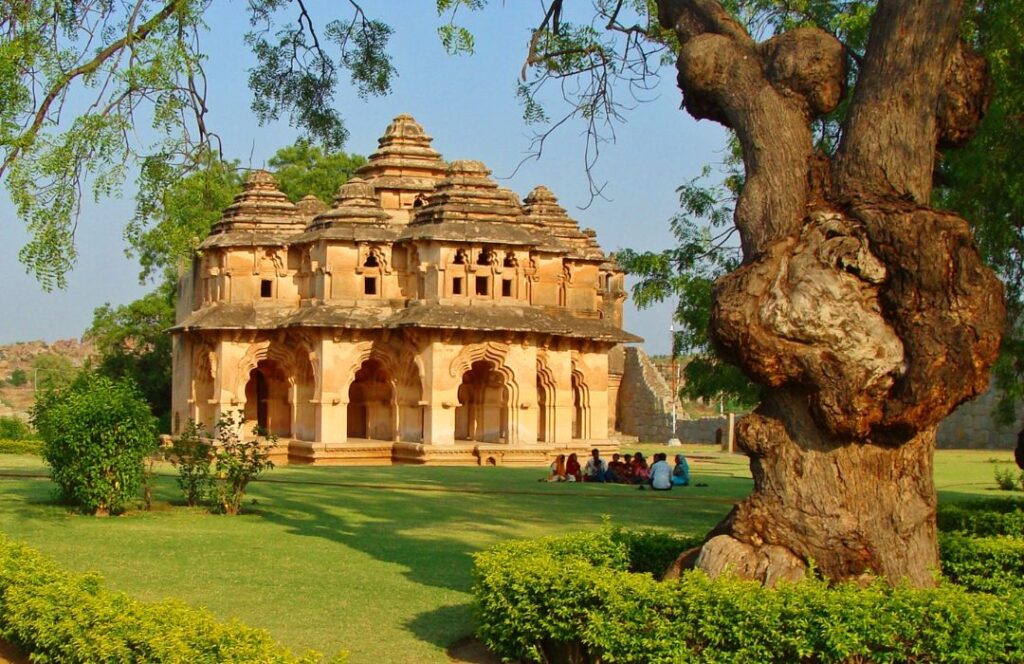
Marvel of History - Hampi, India
Explore the captivating ruins of the Vijayanagara Empire at Hampi, a historical treasure nestled in Karnataka. Transporting visitors to a bygone era, the dispersed ruins of temples, palaces, and markets whisper tales of the empire’s glorious past. As one wanders through the once-majestic capital of Vijayanagara, the city’s rich history comes alive, intricately engraved in stone.
Enhancing this historical marvel are the peculiar rock formations scattered across the landscape. Each rock, balanced precariously, adds to the unique allure of Hampi, creating a captivating contrast against the architectural grandeur of its ancient structures. For enthusiasts of history and nature alike, Hampi beckons as a must-visit destination. Roaming through the labyrinthine ruins not only offers a glimpse into the past but also weaves a poetic narrative, seamlessly merging history with the great outdoors.
Located approximately 12 kilometers from Hospet Junction Railway Station, Hampi is easily accessible via taxis, auto-rickshaws, or local buses. The historical site welcomes visitors from sunrise to sunset, allowing ample time to explore its wonders. The best time to visit Hampi is during the cooler months, from October to March, when the weather is pleasant for sightseeing.
- Location: Hampi is located in Karnataka, India.
- Distance from the nearest railway station: Approximately 12 kilometers from Hospet Junction Railway Station.
- Transportation options: Accessible via taxis, auto-rickshaws, or local buses from Hospet Junction Railway Station.
- Opening hours: Hampi is open to visitors from sunrise to sunset, allowing ample time for exploration.
- Best time to visit: The optimal time to visit is during the cooler months, from October to March, when the weather is pleasant for sightseeing.
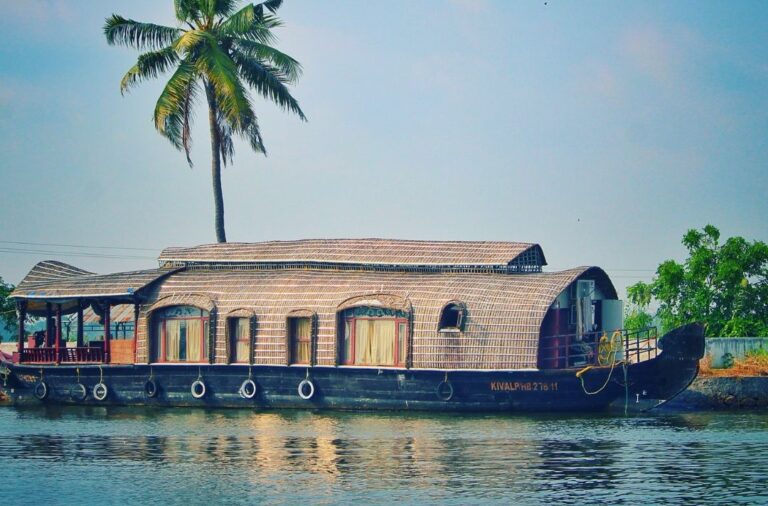
Kerala's backwaters, India
Kerala, adorned with its serene backwaters, paints a tranquil picture that captivates the soul of every traveler. Embarking on a journey across the state’s intricate network of waterways aboard a traditional houseboat offers a unique perspective on Kerala’s lush landscapes and vibrant local culture. As you glide gracefully along the calm waters, lined with picturesque cottages and swaying coconut trees, the backwaters evolve into a serene sanctuary.
Adding to Kerala’s cultural tapestry is the enchanting Kathakali dance, a traditional art form that intricately weaves elaborate movements and vivid costumes to narrate tales from Hindu epics. The performances by skilled Kathakali artists transcend mere entertainment, delving deep into the cultural heritage of the region. Drifting along the gentle ripples of Kerala’s captivating backwaters, visitors are invited to immerse themselves in the essence of the state’s traditions through the harmonious blend of backwater exploration and Kathakali dance.
Situated at various locations across Kerala, accessing the backwaters and Kathakali performances is convenient via local transportation options such as taxis, buses, or hired vehicles from nearby railway stations or airports. The backwaters and Kathakali performances are available throughout the year, with no specific opening or closing times, allowing travelers to indulge in their experiences at their leisure. However, the best time to visit Kerala is during the cooler months from October to March, when the weather is pleasant and ideal for outdoor activities.
Backwaters:
- Location: Kerala, India.
- Transportation options: Accessible via taxis, buses, or hired vehicles from nearby railway stations or airports.
- Best way to experience: Traditional houseboat ride through the intricate network of waterways.
- Scenery: Lush landscapes, charming cottages, and coconut trees lining the tranquil waters.
- Best time to visit: October to March for pleasant weather.
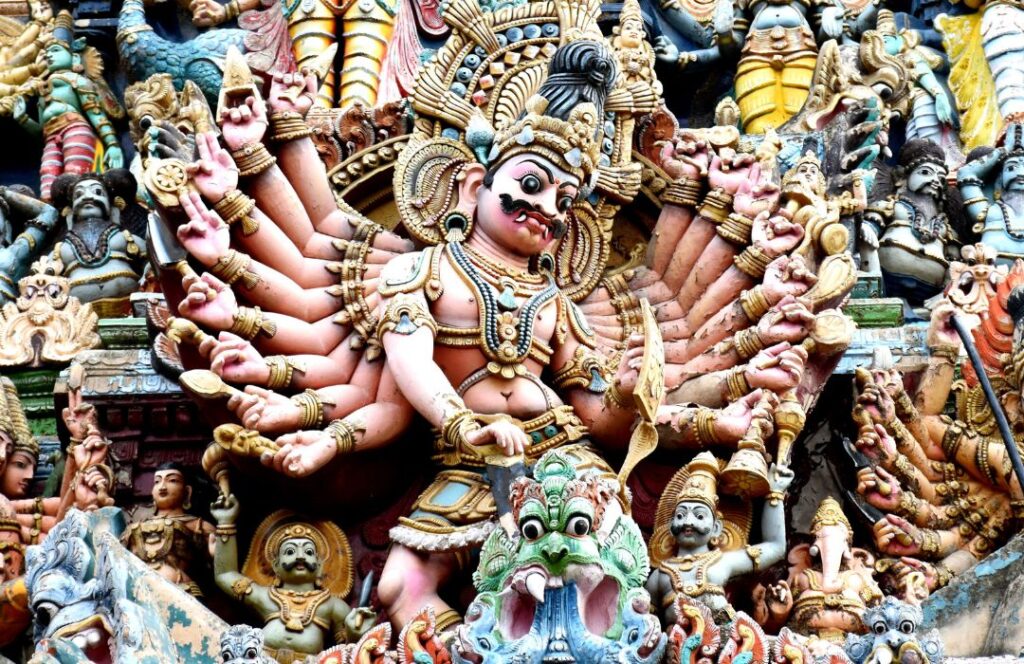
Tamil Nadu temples (at Madurai and Thanjavur), India
Meenakshi Temple, Madurai:
Meenakshi Temple in Madurai, Tamil Nadu, is a magnificent testament to Dravidian architecture and spiritual devotion. Dedicated to Goddess Meenakshi and Lord Sundareswarar, the temple’s towering gopurams, intricate sculptures, and vibrant frescoes enchant visitors. Daily rituals and grand festivals immerse worshippers in a divine atmosphere, while guided tours offer insights into its rich heritage. Surrounded by the bustling city of Madurai, the temple serves as a beacon of cultural significance and spiritual solace, inviting all to experience its timeless beauty and sacred aura.
- Location: Madurai, Tamil Nadu, India.
- Distance from the nearest railway station: Approximately 2 kilometers from Madurai Junction Railway Station.
- Transportation options: Taxis, auto-rickshaws, or walking.
- Opening hours: Open from early morning to late evening for darshan and rituals.
- Best time to visit: Early morning or late afternoon to avoid crowds.
- Ticket price: Free entry, donations appreciated for maintenance.
Brihadeeswarar Temple, Thanjavur:
Brihadeeswarar Temple in Thanjavur, Tamil Nadu, stands as a marvel of Chola architecture and cultural heritage. Built during the Chola dynasty, this UNESCO World Heritage site boasts one of the world’s tallest vimanas and showcases the empire’s patronage of art and culture. The temple’s imposing Nandi, magnificent murals, and soaring Shikhara offer a glimpse into a glorious past. As visitors marvel at its architectural grandeur and spiritual ambiance, Brihadeeswarar Temple remains a timeless symbol of devotion and artistic excellence in South India.
- Location: Thanjavur, Tamil Nadu, India.
- Distance from the nearest railway station: Approximately 2 kilometers from Thanjavur Junction Railway Station.
- Transportation options: Taxis, auto-rickshaws, or walking.
- Opening hours: Similar to Meenakshi Temple, open for darshan and rituals.
- Best time to visit: Early morning or late afternoon for a quieter experience.
- Ticket price: Free entry for Indian nationals, nominal fee for international visitors.

West Bengal's Sunderbans, India
Nestled within the intricate network of the Ganges, Brahmaputra, and Meghna river delta, the Sunderbans unfold as a mysterious labyrinth where land and water merge, creating a unique mangrove habitat. As the world’s largest tidal halophytic mangrove forest, the Sunderbans owe their distinction to the intricate system of water channels and mudflats, exemplifying the delicate balance of nature in this UNESCO World Heritage Site.
This verdant expanse is not only a haven for wildlife enthusiasts but also a botanical wonderland. Within the Sunderbans, a myriad of species thrives, including crocodiles, spotted deer, and a diverse array of birdlife. However, it is the elusive Bengal tiger that reigns as the crown jewel of this environment. Amidst the dense mangrove vegetation, these majestic big cats roam stealthily, forming one of the largest concentrations found in the Sunderbans.
Embarking on a journey to the Sunderbans offers a mesmerizing exploration into the heart of nature’s splendor. Navigating through its intricate canals unveils not only the natural beauty of the mangroves but also provides glimpses into the lives of these extraordinary creatures.
- Distance from the nearest station: Depending on the entry point, access to the Sunderbans can vary. For example, the nearest railway station to the Sundarbans National Park is Canning Railway Station, approximately 48 kilometers away.
- Transportation options: From the nearest railway station, visitors can reach the Sunderbans via taxis or buses.
- Opening hours: Generally, the Sunderbans are accessible for visits during daylight hours. Specific timings may vary depending on the entry point and the activity planned.
- Best time to visit: The ideal time to explore the Sunderbans is during the winter months, from November to February, when the weather is pleasant and wildlife sightings are more frequent.
- Ticket price: Entry fees and safari costs may vary depending on the specific location within the Sunderbans and the type of experience desired.
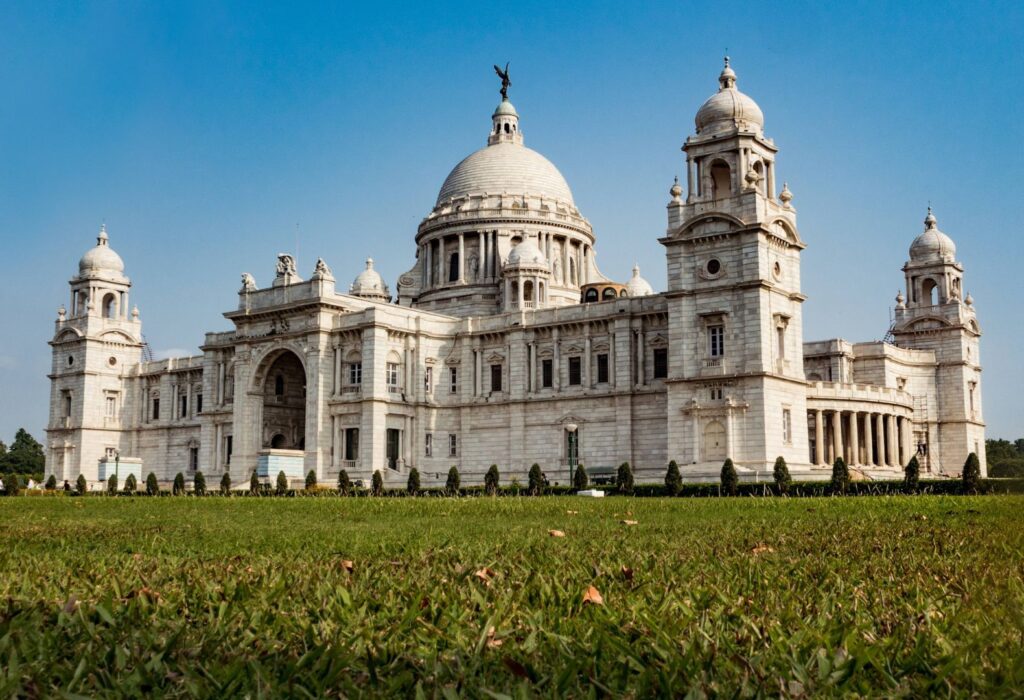
Kolkata, India
Kolkata, draped in colonial elegance, invites exploration of its streets adorned with splendid examples of British architecture. The city serves as a living testament to history, boasting landmarks like the majestic Victoria Memorial and the iconic Howrah Bridge. However, Kolkata transcends its colonial legacy to emerge as a vibrant hub of literature and culture, following the footsteps of luminaries such as Rabindranath Tagore. Beyond its architectural marvels, Kolkata captivates visitors with College Street’s labyrinth of bookstores and the pulsating energy of its festivals.
- Distance from the nearest railway station: Kolkata is well-connected by railways, with Howrah Junction and Sealdah Railway Station being the primary entry points. The distance from these stations to the city center varies but is generally within 5-10 kilometers.
- Transportation options: Kolkata offers various transportation options, including taxis, buses, trams, and the metro, facilitating easy access to its attractions.
- Opening hours: Most attractions in Kolkata operate from morning to evening, with specific timings varying for each site. For example, Victoria Memorial is usually open from 10:00 AM to 5:00 PM.
- Best time to visit: The ideal time to explore Kolkata is during the winter months, from October to March, when the weather is pleasant and conducive to outdoor activities.
- Ticket price: Entry fees for attractions like Victoria Memorial may vary based on factors such as nationality and age. For example, Indian nationals are charged a nominal fee, while foreign tourists pay a higher rate.
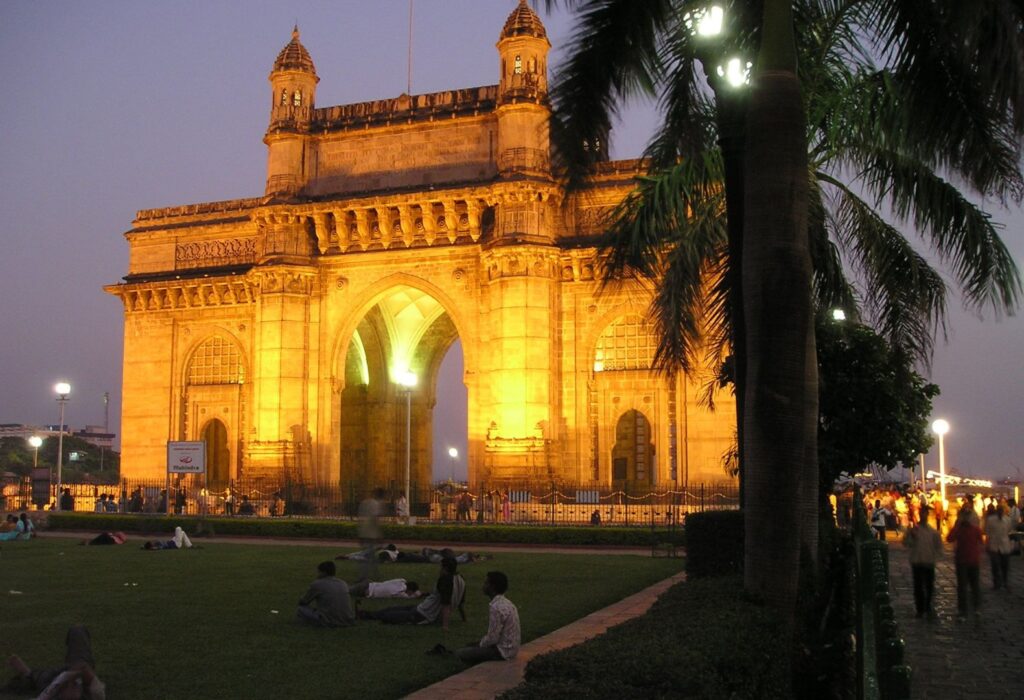
Mumbai, the vibrant city, India
Mumbai, the vibrant heart of West India, pulsates with an energy that mirrors the diverse tapestry of India’s financial and entertainment capital. As the birthplace of Bollywood, the city’s glamorous façade harmonizes seamlessly with its bustling urban life, characterized by the frenetic pace of its inhabitants. Mumbai’s allure is further heightened by its association with the film industry, with its star-studded streets and iconic studios.
Amidst this dynamic metropolitan landscape, historical landmarks like the Gateway of India stand as silent witnesses to Mumbai’s illustrious past. This iconic arch, facing the Arabian Sea, has borne witness to countless historical arrivals and departures, symbolizing the city’s grandeur and resilience. Mumbai embodies a realm where dreams find fruition and history seamlessly intertwines with its bustling present, creating a vibrant mosaic that encapsulates the essence of West India as you navigate its bustling streets.
- Distance from the nearest railway station: Mumbai is served by multiple railway stations, including Chhatrapati Shivaji Maharaj Terminus (CST) and Mumbai Central. The distance from these stations to the Gateway of India is approximately 2-3 kilometers.
- Transportation options: Mumbai offers various transportation options, including taxis, auto-rickshaws, buses, and local trains, providing convenient access to the Gateway of India.
- Opening hours: The Gateway of India is accessible to visitors throughout the day, allowing for exploration at any time. However, it is recommended to visit during daylight hours for optimal visibility and safety.
- Best time to visit: The ideal time to experience the Gateway of India and explore Mumbai’s bustling streets is during the cooler months, from October to March, when the weather is pleasant and conducive to outdoor activities.
- Ticket price: Entry to the Gateway of India is free, allowing visitors to admire its architectural splendor and soak in the surrounding ambiance without any cost.
The Kutch Rann (Gujarat), India
The mesmerizing Rann of Kutch in Gujarat transforms into a captivating masterpiece during the Rann Utsav, where the salt desert glows under the moonlight, exuding an ethereal beauty. This annual event, adorned with traditional dances, music, and the opportunity to camp under the starry sky, offers guests a profound immersion into the region’s rich cultural heritage.
Beyond the enchanting festivities, the Rann of Kutch serves as a cradle of traditional crafts, showcasing the artistic prowess of the Kutchi people. From exquisite jewelry to elaborate needlework and vibrant fabrics, the skilled artisans of the region breathe life into these creations, reflecting the area’s deep-rooted cultural legacy. Exploring the white desert during the Utsav not only offers a visual spectacle but also delves into the heart of Gujarati artistic traditions, where each piece stands as a testament to craftsmanship and resilience.
- Distance from the nearest railway station: The distance from Bhuj Railway Station, the nearest railway station to the Rann of Kutch, is approximately 78 kilometers.
- Transportation options: Visitors can reach the Rann of Kutch from Bhuj by hiring taxis or taking local buses.
- Opening hours: The Rann Utsav typically takes place during the winter months, from November to February, with specific opening and closing times varying each year. However, visitors can explore the Rann of Kutch during daylight hours throughout the year.
- Best time to visit: The winter months offer the best experience due to the cooler weather and the Rann Utsav festivities. November to February is the ideal time to witness the beauty of the salt desert and participate in cultural celebrations.
- Ticket price: The ticket price for the Rann Utsav varies depending on the package chosen, including accommodations and activities. Entry fees for accessing the Rann of Kutch may apply, with rates varying for Indian and international tourists.
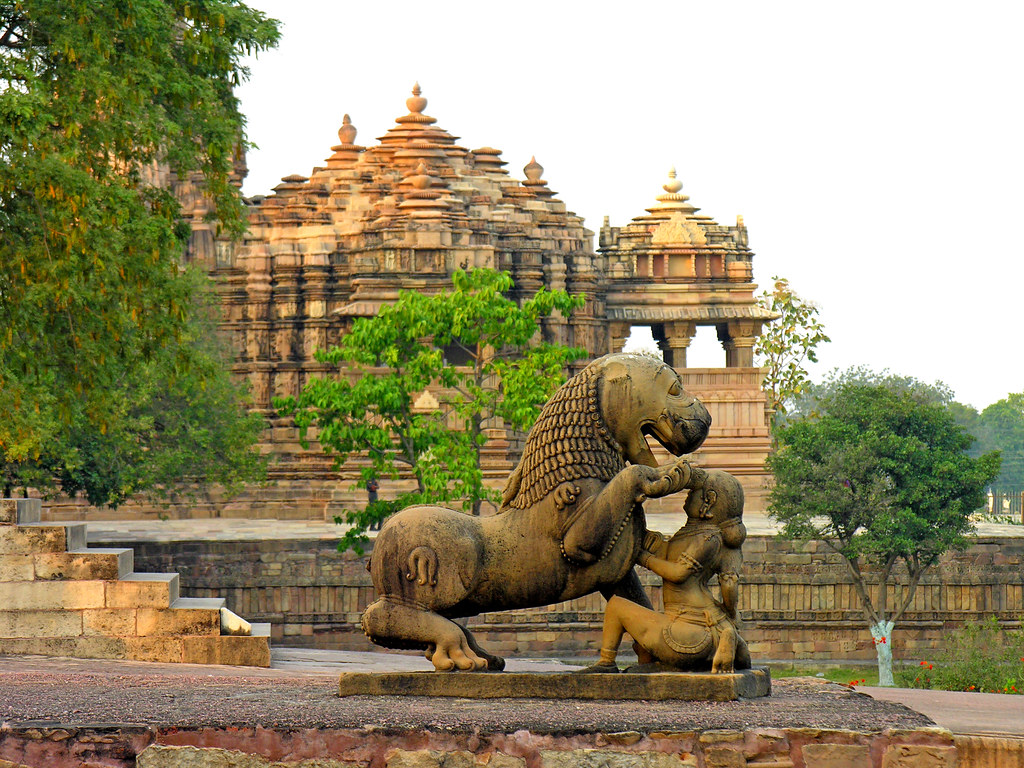
Temples of Khajuraho, India
Nestled in the heart of Central India, the Khajuraho Temples stand as a testament to artistic mastery and cultural diversity. These intricately carved temples, renowned for their candid depictions of divine and human passions, offer visitors a captivating blend of sensuality and spirituality. As guests wander through the labyrinthine buildings crafted from sandstone, they encounter a symphony of emotions etched onto every surface.
Steeped in historical and cultural significance, the Khajuraho Temples transcend mere sculptures to embody a rich tapestry of Jain and Hindu customs. Constructed by the Chandela dynasty between the 9th and 11th centuries, these temples serve as poignant symbols of religious fusion and architectural brilliance. Each structure narrates tales of mythology, spirituality, and ancient Indian life through its elaborate architecture and symbolic carvings.
A journey to Khajuraho offers more than just a visual feast; it provides an immersive dive into Central India’s artistic and cultural heritage. Here, amidst the whispering stones of a bygone era, visitors embark on a profound exploration of history and tradition.
- Distance from the nearest railway station: Khajuraho Railway Station is approximately 5 kilometers from the Khajuraho Temples.
- Transportation options: Taxis, auto-rickshaws, and cycle rickshaws are readily available for transportation from the railway station to the temples.
- Opening hours: The Khajuraho Temples are open to visitors from sunrise to sunset, allowing ample time for exploration.
- Best time to visit: The ideal time to visit Khajuraho is during the winter months, from October to March, when the weather is pleasant and conducive to sightseeing.
- Ticket price: Entry fees for the Khajuraho Temples vary based on nationality, with separate rates for Indian and international visitors. Additionally, there may be fees for camera usage.

Madhya Pradesh National Parks, India
The national parks of Madhya Pradesh, such as Kanha and Bandhavgarh, stand as awe-inspiring wonders of nature. Bandhavgarh, with its rugged terrain, hosts a significant population of Bengal tigers, while Kanha, immortalized as the setting for “The Jungle Book,” boasts rich biodiversity, including rare species like the Barasingha deer. These parks exhibit a diverse tapestry of vegetation, from vibrant meadows to dense sal woods, alongside the majestic presence of their wildlife.
Exploring these sanctuaries is akin to embarking on a profound journey into the heart of conservation, where the untamed melodies of the wilderness echo across the landscapes of Central India. Here, nature thrives at its finest, offering visitors an unparalleled opportunity to witness the splendor of wildlife in its natural habitat.
- Distance from the nearest railway station: The distance from major railway stations to Kanha and Bandhavgarh national parks varies. For example, the nearest railway station to Kanha National Park is Jabalpur Railway Station, approximately 170 kilometers away, while Umaria Railway Station serves as the closest station to Bandhavgarh National Park, around 35 kilometers away.
- Transportation options: Visitors can reach Kanha and Bandhavgarh national parks from nearby railway stations by hiring taxis or booking guided tours.
- Opening hours: The national parks typically open for safaris during specific hours, usually early morning and late afternoon. Exact timings may vary based on the season and park regulations.
- Best time to visit: The ideal time to visit Kanha and Bandhavgarh national parks is during the winter months, from October to March, when the weather is pleasant and wildlife sightings are more frequent.
- Ticket price: Entry fees for safaris and park entry may vary based on factors such as nationality and safari type. Additionally, fees for guides and vehicle hire may apply.
Travel destinations in India form a vibrant mosaic of diversity, offering a rich tapestry of experiences waiting to be uncovered. Each location holds its own unique narrative, from the iconic Taj Mahal to the serene backwaters of Kerala, the ancient wonders of Hampi to the lively culture of Kolkata. India invites exploration with its blend of natural beauty, historical marvels, and cultural richness, whether it’s the wildlife sanctuaries of Central India, the majestic Himalayas, or the ethereal white desert of Kutch. We encourage all readers to fully embrace the spirit of this dynamic country as they embark on their journey, with each destination presenting a blank canvas ready to be painted with unforgettable experiences and new stories. Explore, learn, and allow India’s diverse landscapes and tales to leave an indelible mark on your wanderlust-filled soul.
Top Family-Friendly Destinations in India
- Goa: Beaches, culture, and cuisine.
- Kerala: Backwaters, greenery, and Ayurveda.
- Rajasthan: History, forts, and palaces.
- Shimla and Manali: Mountains and adventure.
- Agra: Taj Mahal and historic sites.
- Darjeeling: Tea gardens and Himalayan views.
- Andaman and Nicobar Islands: Beaches and water activities.
- Munnar: Tea plantations and nature.
- Ranthambore National Park: Wildlife safaris.
- Varanasi: Cultural experiences and Ganges Aarti.
https://indiawanderlust.co.in/best-tourist-places-in-india-for-family-holiday/
the best places to visit in India during the winter months:
Leh-Ladakh, Jammu & Kashmir: Experience surreal landscapes, frozen lakes, and thrilling adventures amidst snow-capped mountains.
Auli, Uttarakhand: Enjoy skiing, snowboarding, and breathtaking views of the Himalayas in this picturesque hill station.
Manali, Himachal Pradesh: Known for its snow-covered landscapes, Manali offers opportunities for skiing, snowshoeing, and exploring the surrounding beauty.
Gulmarg, Jammu & Kashmir: Renowned for its ski resorts and pristine snowscapes, Gulmarg is a paradise for winter sports enthusiasts.
Jaipur, Rajasthan: Explore the Pink City’s majestic forts, palaces, and vibrant markets in the pleasant winter weather.
https://indiawanderlust.co.in/best-winter-destinations-in-india/
